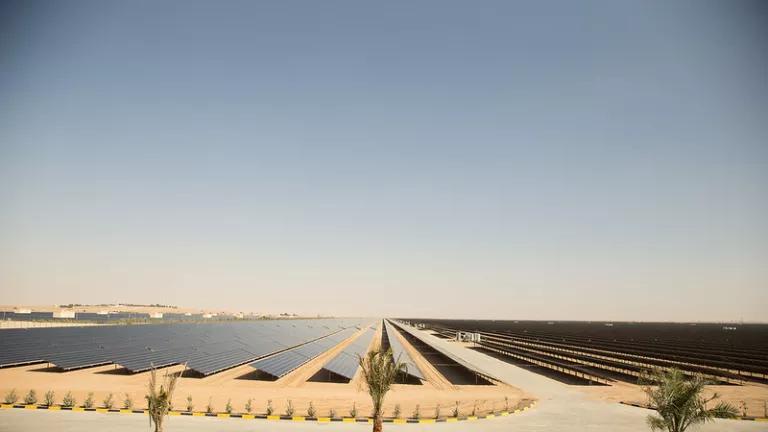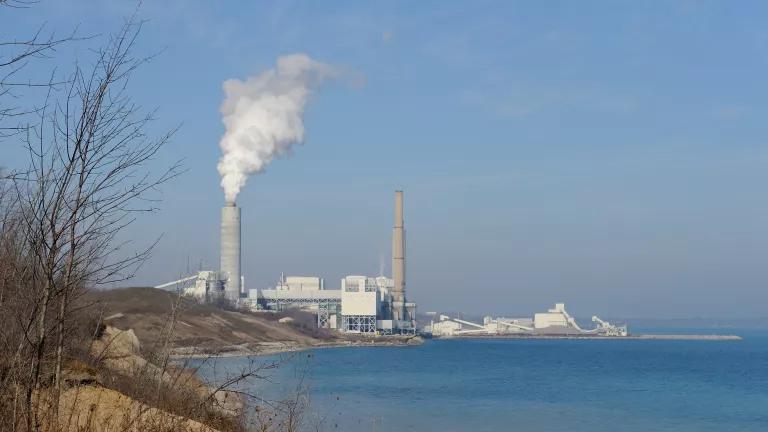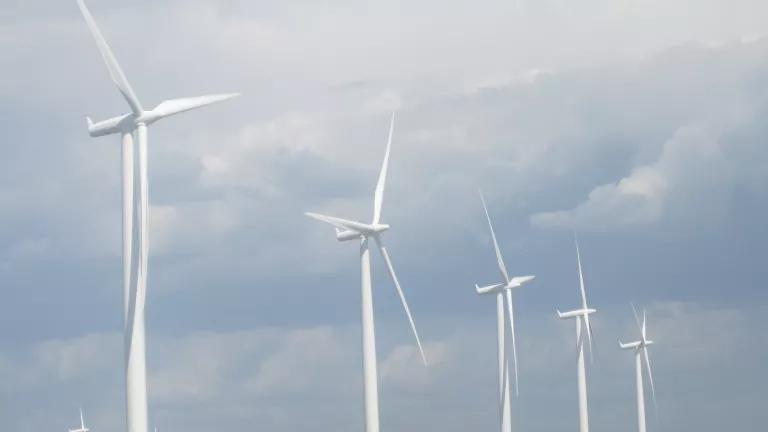How to Rev Up Virginia’s New Climate Action Engine

The Virginia General Assembly made history this session in taking a huge, nation-leading stride toward curbing climate change by passing the Clean Economy Act (VCEA). With the Governor’s forthcoming signature, this transformative, far-sighted climate law requires Virginia’s power plants—most crucially Dominion Energy’s slew of new fracked gas-powered plants—to dial their carbon pollution down to absolute zero by 2050.
We can all celebrate this historic moment in Richmond. Tackling climate change head-on—and now—is a central humanitarian, public safety, and economic challenge of our generation. After years of inaction, moving to carbon-zero by 2050 is the kind of serious action we expect of state and national leaders.
With that long-haul to zero by 2050 in mind, let's look under the VCEA’s hood to be sure its engine goes the distance swiftly, smoothly, and cheaply.
Unfortunately, in the legislative process, electric utilities removed from Virginia’s big new climate vehicle its primary horsepower—energy efficiency—essential for a long-distance drive to 2050. Energy efficiency is the best, cheapest, most direct, and most economy-and-jobs-boosting way to curb the dangers we’re seeing from climate change. And that’s why efficiency was initially the VCEA’s primary means of driving carbon and bill reductions starting this decade and all the way out to 2050.
However, when legislators should have doubled down on energy efficiency and energy equity, they merely dabbled. But they have a chance to amp-up the Clean Economy Act in the next session.
Let’s break it down:
The energy efficiency-driven bill and carbon reductions included in early versions of the VCEA were gutted in the final measure. The most significant efficiency gains, and therefore bill reductions—those after 2025—were written out of the legislation entirely and instead punted to the State Corporation Commission (SCC) for a later, unknown decision on efficiency savings targets. The end result is a Clean Economy Act initially diminished to, at best, one-tenth of the guaranteed efficiency savings it was designed to provide Virginia customers through 2030. Instead of creating certainty that efficiency is a permanent, long-term Virginia clean energy resource for the climate long-haul, the VCEA as passed is a "supply-side" only half-measure, signalling to the utilities that their business-as-usual energy efficiency effort is enough. And that small potatoes ain't much.
Why would Virginia send our marquee climate vehicle off the assembly line with such a low-horsepower engine to get us to zero carbon in 2050?
The answer is unfortunately simple and familiar: the domineering Dominion Energy didn’t like it, and Virginia lawmakers acceded. We had hoped the new General Assembly would flex a bit more muscle and stand up to Dominion's easy-revenue fixation on pumping out more juice, but that didn’t happen on delivering Virginians additional bill-lowering efficiency.
Missing that opportunity to move forward is a loss. Though there is modest progress underway under 2018 efficiency reforms, Virginia's economy will continue to be handicapped under a symbolic new energy efficiency law that is "non-binding," meaning it won't stretch Dominion beyond what will already occur. Meanwhile, Virginia’s utility business model will continue to be prehistoric—one under which Dominion pads profit and revenue by the more stuff they build and the more electricity captive customers burn (instead of being rewarded with profits for better, more efficient energy services for their customers).
Dominion’s death-grip on that Mesozoic business model is why, in total, 90%-100% of the bill-lowering efficiency additions that Virginians could have enjoyed over the next decade were stripped from the VCEA. This was a costly, unnecessary missed opportunity for lawmakers to send a long-term, pro-consumer signal to our monopoly utilities. Dominion, like scores of utilities across the nation, could positively thrive while delivering major energy efficiency savings. But its dogged fixation on an outdated “build more-sell more” business model thwarted, for now, the opportunity for Dominion--and Virginia’s economy--to thrive and grow by growing efficiency savings and lowering bills, all the way out to 2050.
Instead of efficiency-based bill and carbon reductions, NRDC analysis indicates the VCEA will not deliver beyond a middling business-as-usual--vital provisions that must be restored as a cornerstone of consumer-friendly climate action, given that only 6 states in the nation have higher household and commercial bills, and with dramatic and unsustainable Dominion bill increases of at least $29/month already on the way in just the next few years alone.
The good news is this gutting of the VCEA's efficiency component can be partially fixed—immediately—by Governor Northam, by simply sending down an amended VCEA that restores some of the VCEA's efficiency horsepower. And for a more complete restoration of VCEA cost savings, legislators can deliver on their already-stated promise to revisit the hastily-finished package in 2021. That’s thankfully not too long to wait to fully restore the efficiency savings Virginians deserve, to not only drive down emissions cheaply but also deliver big cost reductions to Dominion’s captive customers.
But first, the specifics of how Dominion again hobbled Virginia's economy by putting a "non-binding" EERS on the books.
How Dominion’s VCEA Efficiency Reductions Hobbled Long-term Bill Savings and Local Job Creation
Dominion hacked away at the VCEA's initially-deep commitment to efficiency as a permanent, foundational clean energy resource, down to a negligible and even illusory near-term savings target that is such an easy layup that Dominion is already well on the way to already being done, before the VCEA is even on the books.
Specifically, the VCEA as "enrolled" by the legislature and sent to the governor will very likely simply "require" that Dominion simply meet pre-existing efficiency commitments already required under 2018’s Grid Transformation and Security Act (GTSA), and count them again as their VCEA efficiency requirement as well. Merely re-codifying the 2018 GTSA’s modest efficiency provisions in the 2020 VCEA is a missed economic and environmental opportunity that is hard to overstate.
This watering down was done in two ways: first, by eliminating any energy efficiency post-2025, a drastic amputation of clean energy that senselessly erased almost 90% of the VCEA’s intended cost savings.
The post-2025 efficiency gains that Dominion Energy removed could have delivered average bill reductions of over $17 a month by 2030, and in the process would have ushered in a low-carbon, low-cost approach, and finally free our Virginia economy from Dominion's far costlier “build more -sell more” business model.
The pocketbook benefits would be mirrored by lowest-cost climate benefits: the VCEA’s original efficiency targets would have also delivered over a third of the carbon reductions—from efficiency savings alone—required under Virginia’s 2030 RGGI reduction target.
And because efficiency upgrades—like new insulation and HVAC upgrades—cannot be outsourced, we’re also blowing a key local job-creation measure (you can’t retrofit a Virginia home, church, bigbox store, apartment complex, or office tower from overseas).
Instead of these pocketbook, carbon, and job creation benefits, in their place are meager provisions that simply cut and paste already-standing requirements.
Because Dominion’s weakening amendments didn’t stop with stripping out the VCEA’s most meaningful, post-2025 savings.
Utility amendments also likely eliminated additional VCEA-delivered energy efficiency in the nearer term of 2021-2025: those efficiency “requirements” are requirements in name only, as they will most likely simply be met by the comparatively modest and already-required efficiency investments under 2018's GTSA.
Specifically, there are “business-as-usual” GTSA energy efficiency programs already on the way ("Phase 7" and "Phase 8" programs), and these GTSA programs alone will, with no additional effort by Dominion, account for nearly half of the VCEA's efficiency "requirement." This will hit Low and middle income Virginians in the pocketbook: cutting the VCEA’s efficiency requirement in half eliminates over 5 million MWh of additional Dominion customer savings in 2021-2025 (on top of the removal of over 32 million MWh savings 2026-2030). (For the wonky among us, this removal of over half of the VCEA’s benefits in 2022-2025 is due to the change in standard from the widespread “incremental” (lines 175-179 in the as-filed bill) to “total annual” (lines 255-262 in the enrolled bill), a less commonly used efficiency measurement standard that allows utilities to “count” savings from already-existing efficiency measures.)
The remaining 2020-2025 efficiency requirement, not met by existing or expected GTSA efficiency programs, will most likely be similarly met -- and possibly exceeded -- by the GTSA’s already-existing statutory efficiency investment requirement of $870 million. Of that $870 million requirement, Dominion has already committed over $370 million, and NRDC's analysis simply assumes Dominion fulfills the remainder of its 2018 GTSA investment commitment as expected before 2025 (or about $124 million in 2021 through 2024). In that likely case, the resulting GTSA savings will very likely meet or even exceed the current VCEA efficiency requirement, perversely making the enrolled VCEA less effective at delivering efficiency savings than the two-year old GTSA.
To summarize, because this is important stuff: the 2018 GTSA required a relatively modest ramp-up of basic efficiency programs (also in return for another massive, multi-billion dollar customer-funded spending spree by Dominion). And due to a definition change that Dominion tucked into the VCEA (changing the more robust "incremental" savings to the watered down "total annual" savings), those modest GTSA requirements will meet about half of the VCEA efficiency targets (which were already watered down by 90% with the removal of all post-2025 efficiency requirements). That definition change does so by permitting Dominion to count savings from already-installed, business-as-usual GTSA efficiency programs toward subsequent annual savings requirements. The remaining 50% of the VCEA's "required" savings will likely be covered by Dominion's remaining GTSA efficiency commitment of nearly $500 million. Dominion's “double dip” into extant GTSA efficiency commitments defeats an efficiency standard's primary purpose: ensure monopoly utilities deliver bill reductions beyond what they would under already-existing policy.
Dominion’s Efficiency Cuts Also Hobbled Virginia's Near-term Climate Action
Along with eliminating bill savings, utility elimination of the VCEA’s efficiency additions harms its climate action impact as well: NRDC analysis of the VCEA indicates the energy efficiency levels stripped out by utility amendments would have reduced carbon pollution from our electric grid by 20.5 million tons by 2030. The efficiency provisions in the enrolled VCEA, however, will, in the best case scenario, deliver just 2.7 tons of carbon reductions, and possibly none, again depending on the level of “business-as-usual” efficiency delivered under the 2018 GTSA.
Thankfully, restoring some level of efficiency savings and carbon reductions in the near-term is easily rectified by a simple two-word Governor’s amendment to the VCEA.
But legislative action in 2021 will still be needed to ensure the VCEA delivers additional efficiency beyond the GTSA.
Here's How the Governor and Legislature Can Make Simple CEA Upgrades to Rev VA’s Action Engine Back Up, for the Long Haul to 2050
Even despite Dominion’s shenanigans in monkeying up the VCEA, make no mistake: the clearest long-term benefit of the Clean Economy Act is its 2050 zero-carbon marker. That landmark milestone remains intact and with all its teeth. Just as important, the VCEA still includes a multitude of cost-lowering, job-creating tools to help achieve that target over the long-term: rooftop solar, utility scale solar along with big land-based and offshore wind, battery storage, factoring in the society-wide cost of carbon pollution in future resource decisions. The transformative potential of these resources and policies cannot be overstated, and must be celebrated.
But despite having that solid chassis and a clear roadmap to 2050, the Clean Economy Act still came off the line missing its most serious horsepower for a three-decade long-haul. That is why robust, post-2025, and permanent energy efficiency targets must be restored to the VCEA.
And that will include removing the deferral of future target setting to the SCC: despite the utilities’ strong preference for specific legislative mandates of billions of dollars in supply-side additions underwritten by Virginia residents, it is no accident that utility amendments by contrast secured SCC determination and approval of energy efficiency levels. Simply put, enacting SCC control over energy efficiency levels creates needless uncertainty that is bad for customers and good for Dominion shareholders.
Cumbersome proceedings to deliberate the appropriate levels of energy efficiency utilities must procure—overseen by an SCC historically hostile to energy efficiency—is an entirely unnecessary delay that wastes taxpayer dollars and signals to the utilities that they need not prioritize efficiency over more expensive supply side resources. Indeed, an unknown post-2025 efficiency standard, to be determined by the SCC at a later date, is effectively the same as no standard at all, in terms of least-cost planning and supply-side resource acquisition by utilities.
Punting standard setting to the SCC to set annual commonsense energy savings levels utilities must procure, for no discernible reason – other than a self-interested utility preference contrary to consumer protections – is a harmful delay, and inexplicably misses the opportunity to send a clear long-term investment signal to utilities that energy efficiency is a permanent, foundational resource to control utility bills for all Virginians.
Thankfully, legislators are well aware that they sent the VCEA out of the garage with key customer-protection components missing, and that they’ll need to do some significant but straightforward fixes under the hood when they join us back in Richmond next year. They can do just that, first and foremost, by fully restoring post-2025 efficiency standards, to tell Dominion loud-and-clear we expect them not just to dabble in energy for the next few years, but to double-down, permanently, on customer bill savings and the cheapest carbon reductions.
In the meantime, for a more immediate fix in the next few weeks, the Governor must amend Dominion’s efficiency “double-dip” with a few key phrases, to fully restore efficiency as the near-term engine to drive both carbon and costs down, and local job creation up.
With quick action from the Governor, and subsequent 2021 action from the legislature next session, Virginia can finally get serious about efficiency. In doing so, Virginians will have even more cause to celebrate climate action that delivers not just lower carbon, but lower costs to all.




